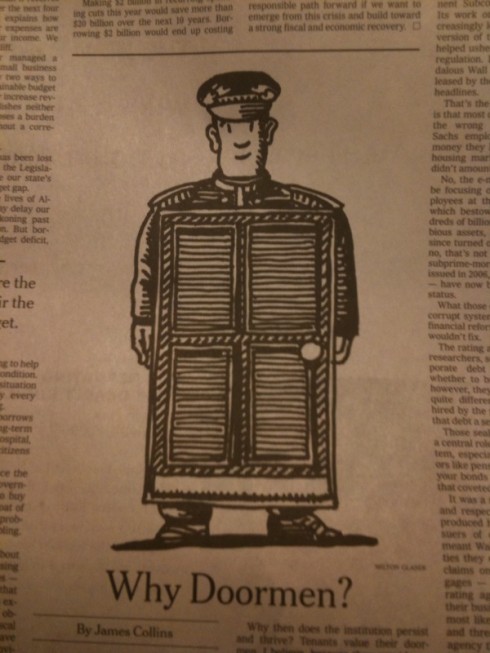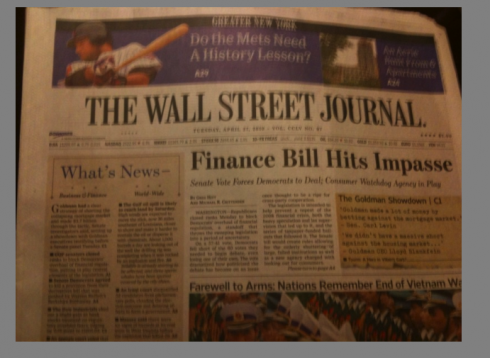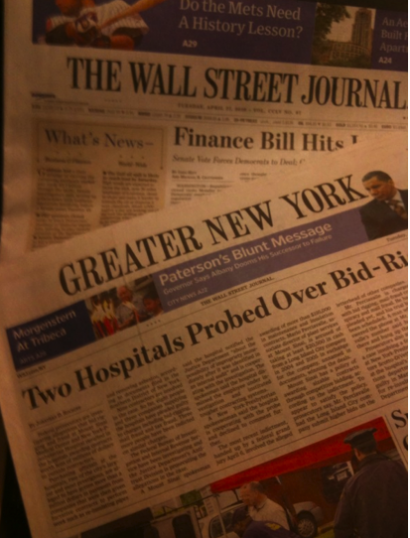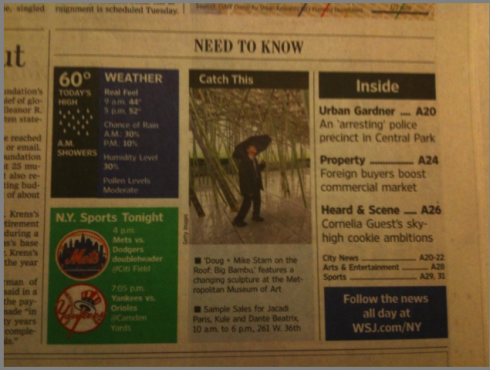Update #2: Tuesday, April 27, 08:30 EST
TAKEAWAY: The iPad is everywhere one turns in New York City, and, although it is likely to become the story boutique of the future, we still do not see that level of storytelling by the newspaper editions that are taking their first baby steps into the new platform PLUS: A surprise in print that was not in the iPad AND: The INMA Congress is on here in New York City, and digital publishing plays a key role in the program. PLUS: A look at the Wall Street Journal’s Greater New York edition
Some early lessons from the iPad

Photos in this composite by Stefan Seffrin
The publishing world has now had some time to examine Apple’s iPad, the tablet that is likely to be the game changer for how we receive information and, hopefully for the newspaper and magazine industry, how we get our credit cards out to pay for subscriptions, or simply to download that favorite column that we just can’t survive without reading.
It is too early to tell if the iPad, or another of the several tablets looming in the horizon, will , in fact, fulfill the expectations. Surely, there is a tablet in your future, whether you are a journalist or a media consumer. So I am fascinated by what we have learned so far, especially as it applies to how a newspaper or magazine tabletizes:
1.Nobody wants the entire page content as it appears in print to land on the screen.
2.A special tablet edition is in order, with a superbly edited version of the editor’s choice of the best content, with special emphasis on multimedia. What are the stories from print that have received tablet enhancements?
3. The iPad is like a pop up book, it must surprise, and there is nothing linear or flat about it.
4. This is why the role of storytelling is key to a successful tablet edition, especially photography, which will become ever more important, each photo a huge canvas full of ministories.
Hollywood has often been described as a dream factory. The iPad can be the ultimate story boutique, as long as the creative people recognize its potential as a unique medium and not a mere dumping ground for the printed edition.
But the story boutique is not open yet. Newspapers and magazines are going into iPad territory cautiously one step at a time (as it should be), and not even crawling yet, allowing us who tinker with our iPads to dream of all the possibilities. The demos we saw in anticipation of the iPad’s arrivals have not quite materialized fully yet. Print still casts a large shadow. But we know that good things come with time for those who wait.
Paper surprises

Here is the Milton Glaser illustration as it appeared on Monday’s print edition of The New York Times
But, alas, although I had read The New York Times’ Editors’ Choices on my iPad during breakfast this morning, the big surprise was in the printed edition, which I read much letter.
Yes, illustrating a column by James Collins titled “Why Doormen?” (about an averted strike by the doormen who grace the fancy doors of even fancier buildings along the Upper East Side), guess who had done the illustration for this piece? Milton Glaser.. Here is an example of the big surprise in print that was not among the editor’s choices on the iPad. I am glad that, on this particular day, I happened to be in NYC with access to the printed edition.
The iPad: High flying and adored
A Mexican friend attending the INMA Congress here in New York City tells me that he was able to use his iPad to connect and to go online while flying!
While on the subject, I counted 9 iPads in the dining room of the Intercontinental Barclays hotel during breakfast yesterday, so, while an iPad on display anywhere in Europe is still reason for people to stop by and to ask if they can touch this marvelous little machine, in the US it’s becoming as common as, well, the iPhones.
Many of those iPad users probably got their toy while here in NYC. I stopped at the Apple Store on Fifth Avenue, which never closes, and the line of customers to buy an iPad was at least 20 minutes wait Saturday, almost a month after the first iPads went on sale. Most of the customers on line appeared to be foreign visitors who probably wanted to be the first to land back home with the most coveted toy of the season.
The iPad and the INMA Congress

I will be one of the speakers today at the 80th Annual INMA World Congress. A review of the program shows the diversity of topics, but also the interest and emphasis on digital publishing for these newspaper marketing folks representing 47 countries. My session is titled: “Selling Print to Readers and Advertisers in the Times of the iPad and Beyond”.
Sessions go by titles such as “Driving Commercial Value from Content in the Digital Age” or “How to Prepare Now for the New Digital Advertising Landscape”. Although I am intrigued by a session titled “Time Out: To Shift a Culture, You must Focus on the Individual”.
Specifically related to tablets: “E-readers and the iPad: Future of the platform, content, revenue options”, a session led by Roger Fidler, program director for Digital Publishing, University of Missouri.
WSJ’s Greater New York: sold out?

The front page of the WSJ’s Greater New York edition: the promos at the top are geared to local content, rest is same as before

The front of Greater New York: very local, but in terms of design very 1980s. Headlines and text, no summaries or secondary points of entry

Best feature on page one of the Greater New York section: a Need to Know box that gives you instant information on the weather, NY Sports Tonight, two teasers under Catch This, and the regular best of the inside.
It is day two of the Wall Street Journal’s new and enhanced Greater New York edition, an attempt by the Murdoch team to give The New York Times a little local competition. (Meanwhile, as I write this Tuesday morning, watching the Today show on NBC, I have heard the NYT’s ad proclaiming that it is New York City’s newspaper, and that it knows the city like nobody else does.)
We may be witness to what Sarah Ellison, author of the forthcoming War at the Wall Street Journal, refers to as “the last great newspaper war of the 20th century.”
Early verdict: This is no official marketing research, but today I tried to buy a copy of the WSJ three times while coming back from my Central Park run. I stopped by street vendors on Fifth Avenue, then Madison, then finally Park Avenue, and the WSJ of today was sold out at all of these locations, although copies of the NY Times were still available.
I finally got a copy of the WSJ from the hotel concierge.
Some comments:
1. The front page of the Greater New York edition is business as usual, except for a promo box at the top devoted entirely to local news that one can find in the Greater New York section (pages A19-32.
2. The Greater New York section is 12 pages, including police/political news, Regional Report, ,Heard &Scene (fashion,social scene),an Arts & Entertainment page and even two Sports pages .
As someone who has been involved as a consultant with previous redesigns of the WSJ over the years, what I miss here is the use of consistent secondary elements such as summaries under headlines, to help scanners move through the section. At least in today’s edition, it is mostly headlines then text, the way we used to do it in the early 1980s and before. Hardly a subhead appears anywhere. With the exception of the sports editors, who seems to like summaries or strap headlines, the rest of the paper is basic heads/text and photos.
If you blink you miss the visual WSJ DNA here. It could be the local section of a newspaper in New Jersey, Pennsylvania or Kansas.
This is a radical departure from what I recall during my days with the WSJ, when everything that was ever created new HAD to live up to the visual roots of the newspaper.
Progress and profit sometimes dictate separations from history and tradition.
An interesting sidebar:
The last page of today’s WSJ is an ad from Design Within Reach, a design studio in New York City, which uses its space to offer Congratulations to the Wall Street Journal: “We look forward to your coverage of the city’s people, politics and sports. But when it comes to modern design in New York, we’ve got that covered”.
Of related interest:
http://www.slate.com/id/2252046/